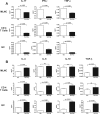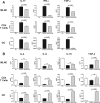Coinfection with the intestinal nematode Heligmosomoides polygyrus markedly reduces hepatic egg-induced immunopathology and proinflammatory cytokines in mouse models of severe schistosomiasis
- PMID: 18710859
- PMCID: PMC2573333
- DOI: 10.1128/IAI.00673-08
Coinfection with the intestinal nematode Heligmosomoides polygyrus markedly reduces hepatic egg-induced immunopathology and proinflammatory cytokines in mouse models of severe schistosomiasis
Abstract
Infection with the trematode helminth Schistosoma mansoni results in a parasite egg-induced, CD4 T-cell-mediated, hepatointestinal granulomatous and fibrosing inflammation that varies greatly in severity, with a higher frequency of milder forms typically occurring in regions where the disease is endemic. One possible explanation for this is that in these regions the degree of inflammation is lessened by widespread concurrent infection with gastrointestinal nematodes. We tested this hypothesis by establishing a murine coinfection model in which mice were infected with the intestinal nematode parasite Heligmosomoides polygyrus prior to infection with S. mansoni. In CBA mice that naturally display a severe form of schistosomiasis, preinfection with H. polygyrus resulted in a marked reduction in schistosome egg-induced hepatic immunopathology, which was associated with significant decreases in the levels of interleukin-17 (IL-17), gamma interferon, tumor necrosis factor alpha, IL-23, IL-6, and IL-1beta and with increases in the levels of IL-4, IL-5, IL-10, and transforming growth factor beta in mesenteric lymph node cells, purified CD4 T cells, and isolated liver granuloma cells. There also were increases in liver Ym1 and forkhead box P3 transcription factor expression. In another model of high-pathology schistosomiasis induced in C57BL/6 mice by immunization with schistosome egg antigens in complete Freund's adjuvant, coinfection with the nematodes also resulted in a marked inhibition of hepatic immunopathology accompanied by similar shifts in cytokine production. These findings demonstrate that intestinal nematodes prevent Th1- and Th17-cell-mediated inflammation by promoting a strong Th2-polarized environment associated with increases in the levels of alternatively activated macrophages and T regulatory cells, which result in significant amelioration of schistosome-induced immunopathology.
Figures






References
-
- Adewusi, O. I., N. A. Nix, X. Lu, D. G. Colley, and W. E. Secor. 1996. Schistosoma mansoni: relationship of tumor necrosis factor-alpha to morbidity and collagen deposition in chronic experimental infection. Exp. Parasitol. 84115-123. - PubMed
-
- Aggarwal, S., N. Ghilardi, M. H. Xie, F. J. de Sauvage, and A. L. Gurney. 2003. Interleukin-23 promotes a distinct CD4 T cell activation state characterized by the production of interleukin-17. J. Biol. Chem. 2781910-1914. - PubMed
-
- Annacker, O., R. Pimenta-Araujo, O. Burlen-Defranoux, T. C. Barbosa, A. Cumano, and A. Bandeira. 2001. CD25+ CD4+ T cells regulate the expansion of peripheral CD4 T cells through the production of IL-10. J. Immunol. 1663008-3018. - PubMed
Publication types
MeSH terms
Substances
Grants and funding
LinkOut - more resources
Full Text Sources
Other Literature Sources
Research Materials
Miscellaneous

